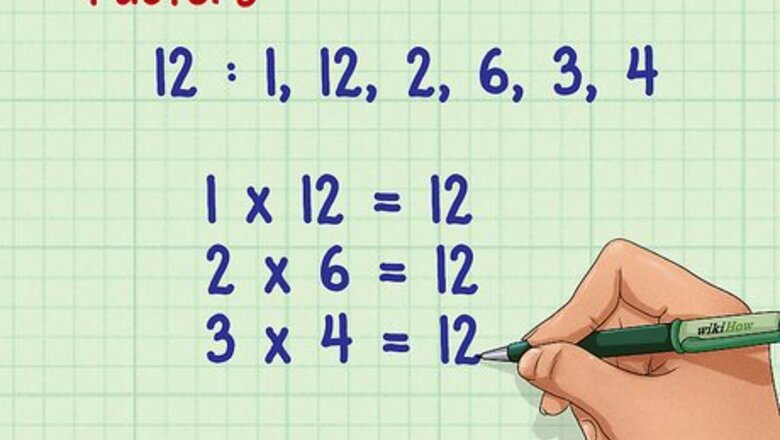
views
X
Research source
Factoring Numbers and Basic Algebraic Expressions

Understand the definition of factoring when applied to single numbers. Factoring is conceptually simple, but, in practice, can prove to be challenging when applied to complex equations. Because of this, it's easiest to approach the concept of factoring by starting with simple numbers, then move on to simple equations before finally proceeding to more advanced applications. A given number's factors are the numbers that multiply to give that number. For example, the factors of 12 are 1, 12, 2, 6, 3 and 4, because 1 × 12, 2 × 6, and 3 × 4 all equal 12. Another way to think of this is that a given number's factors are the numbers by which it is evenly divisible. Can you find all the factors of the number 60? We use the number 60 for a wide variety of purposes (minutes in an hour, seconds in a minute, etc.) because it's evenly divisible by a fairly wide range of numbers. The factors of 60 are 1, 2, 3, 4, 5, 6, 10, 12, 15, 20, 30, and 60.

Understand that variable expressions can also be factored. Just as lone numbers can be factored, so too can variables with numeric coefficients be factored. To do this, simply find the factors of the variable's coefficient. Knowing how to factor variables is useful for simplifying algebraic equations that the variables are a part of. For example, the variable 12x can be written as a product of the factors of 12 and x. We can write 12x as 3(4x), 2(6x), etc., using whichever factors of 12 are best for our purposes. We can even go as far as to factor 12x multiple times. In other words, we don't have to stop with 3(4x) or 2(6x) - we can factor 4x and 6x to give 3(2(2x) and 2(3(2x), respectively. Obviously, these two expressions are equal.
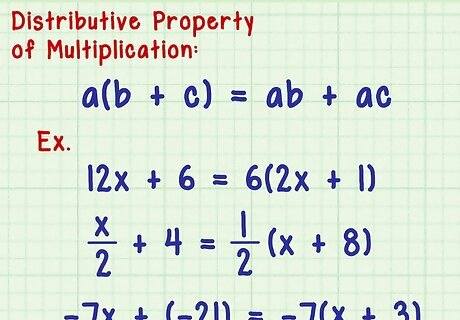
Apply the distributive property of multiplication to factor algebraic equations. Using your knowledge of how to factor both lone numbers and variables with coefficients, you can simplify simple algebraic equations by finding factors that the numbers and variables in an algebraic equation have in common. Usually, to make the equation as simple as possible, we try to search for the greatest common factor. This simplification process is possible because of the distributive property of multiplication, which states that for any numbers a, b, and c, a(b + c) = ab + ac. Let's try an example problem. To factor the algebraic equation 12 x + 6, first, let's try to find the greatest common factor of 12x and 6. 6 is the biggest number that divides evenly into both 12x and 6, so we can simplify the equation to 6(2x + 1). This process also applies to equations with negatives and fractions. x/2 + 4, for instance, can be simplified to 1/2(x + 8), and -7x + -21 can be factored to -7(x + 3). EXPERT TIP Joseph Meyer Joseph Meyer Math Teacher Joseph Meyer is a High School Math Teacher based in Pittsburgh, Pennsylvania. He is an educator at City Charter High School, where he has been teaching for over 7 years. Joseph is also the founder of Sandbox Math, an online learning community dedicated to helping students succeed in Algebra. His site is set apart by its focus on fostering genuine comprehension through step-by-step understanding (instead of just getting the correct final answer), enabling learners to identify and overcome misunderstandings and confidently take on any test they face. He received his MA in Physics from Case Western Reserve University and his BA in Physics from Baldwin Wallace University. Joseph Meyer Joseph Meyer Math Teacher The distributive property helps you avoid repetitive calculations. You can use the distributive property to solve equations where you must multiply a number by a sum or difference. It simplifies calculations, enables expression manipulation (like factoring), and forms the basis for solving many equations.
Factoring Quadratic Equations
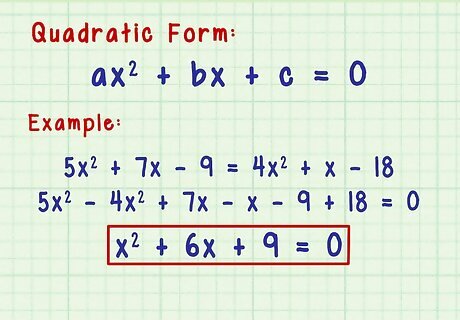
Ensure the equation is in quadratic form (ax + bx + c = 0). Quadratic equations are of the form ax + bx + c = 0, where a, b, and c are numeric constants and a does not equal 0 (note that a can equal 1 or -1). If you have an equation containing one variable (x) that has one or more terms of x to the second power, you can usually shift the terms in the equation around using basic algebraic operations to get 0 on one side of equals sign and ax, etc. on the other side. For example, let's consider the algebraic equation. 5x + 7x - 9 = 4x + x - 18 can be simplified to x + 6x + 9 = 0, which is in the quadratic form. Equations with greater powers of x, like x, x, etc. can't be quadratic equations. They are cubic equations, quartic equations, and so on, unless the equation can be simplified to eliminate these terms of x above the power of 2.
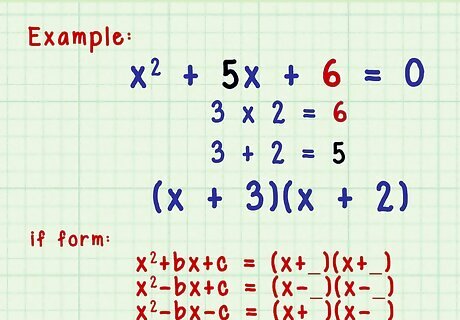
In quadratic equations where a = 1, factor to (x+d )(x+e), where d × e = c and d + e = b. If your quadratic equation it is in the form x + bx + c = 0 (in other words, if the coefficient of the x term = 1), it's possible (but not guaranteed) that a relatively simple shortcut can be used to factor the equation. Find two numbers that both multiply to make c and add to make b. Once you find these two numbers d and e, place them in the following expression: (x+d)(x+e). These two terms, when multiplied together, produce your quadratic equation - in other words, they are your quadratic equation's factors. For example, let's consider the quadratic equation x + 5x + 6 = 0. 3 and 2 multiply together to make 6 and also add up to make 5, so we can simplify this equation to (x + 3)(x + 2). Slight variations on this basic shortcut exist for slight variations in the equation itself: If the quadratic equation is in the form x-bx+c, your answer is in this form: (x - _)(x - _). If it is in the form x+bx+c, your answer looks like this: (x + _)(x + _). If it is in the form x-bx-c, you answer is in the form (x + _)(x - _). Note: the numbers in the blanks can be fractions or decimals. For example, the equation x + (21/2)x + 5 = 0 factors to (x + 10)(x + 1/2).
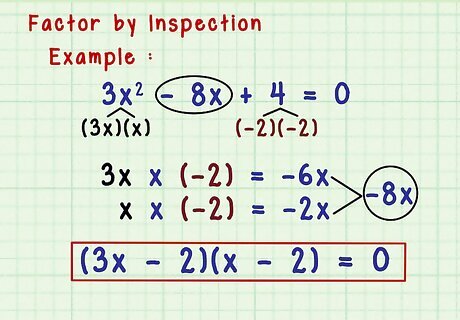
If possible, factor by inspection. Believe it or not, for uncomplicated quadratic equations, one of the accepted means of factoring is simply to examine the problem, then just consider possible answers until you find the right one. This is also known as factoring by inspection. If the equation is in the form ax+bx+c and a>1, your factored answer will be in the form (dx +/- _)(ex +/- _), where d and e are nonzero numerical constants that multiply to make a. Either d or e (or both) can be the number 1, though this is not necessarily so. If both are 1, you've essentially used the shortcut described above. Let's consider an example problem. 3x - 8x + 4 at first seems intimidating. However, once we realize that 3 only has two factors (3 and 1), it becomes easier, because we know that our answer must be in the form (3x +/- _)(x +/- _). In this case, adding a -2 to both blank spaces gives the correct answer. -2 × 3x = -6x and -2 × x = -2x. -6x and -2x add to -8x. -2 × -2 = 4, so we can see that the factored terms in parentheses multiply to become the original equation.
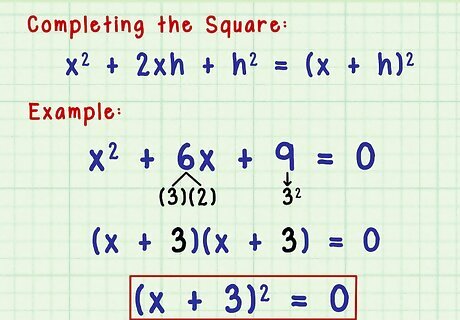
Solve by completing the square. In some cases, quadratic equations can be quickly and easily factored by using a special algebraic identity. Any quadratic equation of the form x + 2xh + h = (x + h). So, if, in your equation, your b value is twice the square root of your c value, your equation can be factored to (x + (sqrt(c))). For example, the equation x + 6x + 9 fits this form. 3 is 9 and 3 × 2 is 6. So, we know that the factored form of this equation is (x + 3)(x + 3), or (x + 3).

Use factors to solve quadratic equations. Regardless of how you factor your quadratic expression, once it is factored, you can find possible answers for the value of x by setting each factor equal to zero and solving. Since you're looking for values of x that cause your equation to equal zero, a value of x that makes either of your factors equal zero is a possible answer for your quadratic equation. Let's return to the equation x + 5x + 6 = 0. This equation factored to (x + 3)(x + 2) = 0. If either of the factors equals 0, the entire equation equals 0, so our possible answers for x are the numbers that make (x + 3) and (x + 2) equal 0. These numbers are -3 and -2, respectively.

Check your answers - some of them may be extraneous! When you've found your possible answers for x, plug them back in to your original equation to see if they are valid. Sometimes, the answers you find don't cause the original equation to equal zero when plugged back in. We call these answers extraneous and disregard them. Let's plug -2 and -3 into x + 5x + 6 = 0. First, -2: (-2) + 5(-2) + 6 = 0 4 + -10 + 6 = 0 0 = 0. This is correct, so -2 is a valid answer. Now, let's try -3: (-3) + 5(-3) + 6 = 0 9 + -15 + 6 = 0 0 = 0. This is also correct, so -3 is also a valid answer.
Factoring Other Forms of Equations

If the equation is in the form a-b, factor it to (a+b)(a-b). Equations with two variables factor differently than basic quadratics. For any equation a-b where a and b do not equal 0, the equation factors to (a+b)(a-b). For example, the equation 9x - 4y = (3x + 2y)(3x - 2y).
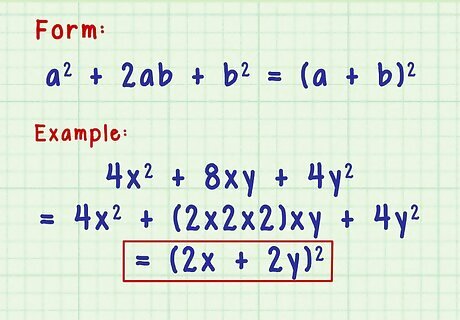
If the equation is in the form a+2ab+b, factor it to (a+b). Note that, If the trinomial is in the form a-2ab+b, the factored form is slightly different: (a-b). The equation 4x + 8xy + 4y can be re-written as 4x + (2 × 2 × 2)xy + 4y. We can now see that it's in the correct form, so we can say with confidence that our equation factors to (2x + 2y)
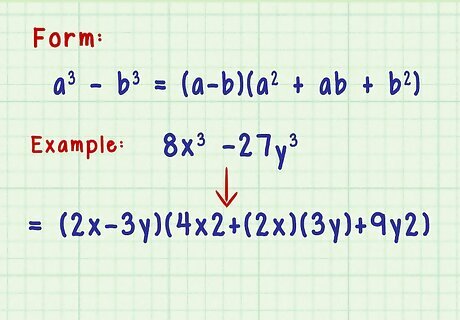
If the equation is in the form a-b, factor it to (a-b)(a+ab+b). Finally, it bears mentioning that cubics and even higher-order equations can be factored, though the factoring process quickly becomes prohibitively complicated. For instance, 8x - 27y factors to (2x - 3y)(4x + ((2x)(3y)) + 9y)




















Comments
0 comment